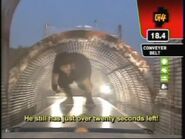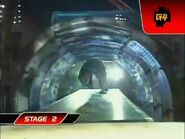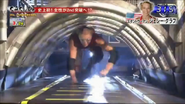Gyakusō Conveyor (逆走コンベアー), called Conveyer Belt in English broadcasts, is a Second Stage obstacle from the first thirteen SASUKE tournaments. Variants of this obstacle were also used in several Kinniku Banzuke events.
It is exactly what its name implies: a conveyor belt with an overhang covering it. Competitors must crawl across the conveyor belt from one side to the other. The conveyor belt is 8 metres long and moves at the speed 20 km/h in the opposite direction of the competitors. In the first tournament, competitors must enter from the left side of the conveyor, however, this was changed from SASUKE 2 to SASUKE 6, where competitors now must enter from the right side of the conveyor. It was reverted back from SASUKE 7 onwards (including Reverse Conveyor).
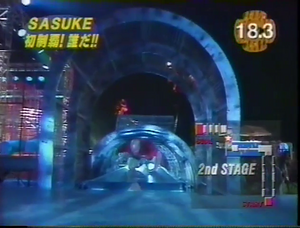
Travis Allen Schroeder attempting Gyakusō Conveyor in SASUKE 4
In SASUKE 8, the whole course was showered with a typhoon that unleashed a heavy rain. This caused several obstacles to have trouble functioning, with Gyakusō Conveyor being one of it. To prevent the dangers of getting electrocuted, the belt was turned off, so it didn't move at all, however the rain that had fallen on the belt while it was not moving had left the belt slippery. This caused some competitors to slip and struggle before finally making it to Wall Lifting, proven by Nakata Daisuke timing out on Wall Lifting due to the struggle on this obstacle.
Designed as time waster, it only eliminated two competitors (Atarashii Ichirō in SASUKE 4 and Ueki Shigenori in SASUKE 13) and was replaced with Metal Spin in SASUKE 14, which acquired a reputation as a feared obstacle.
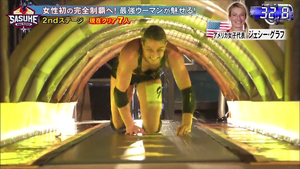
Jessie Graff attempting Reverse Conveyor
in SASUKE 37
It was eventually revived in SASUKE 32 after a hiatus of 12 years and 19 tournaments. Placed as the seventh obstacle of Second Stage, it is now named as Reverse Conveyor (リバースコンベアー). It was placed between Backstream and Wall Lifting.
A padding was added behind the conveyor belt if competitors fail to clear it due to fatigue, which became another way to fail this obstacle. The padding was replaced by water in SASUKE 35. On a side note, similar layout was already in use since its first appearance in SASUKE 1.
However, the speed of the conveyor belt had been decelerated compared to previous tournaments, likely due to the risk of going onto an electric obstacle after being inundated with the water from Backstream.
Similar to its appearance in the early tournaments, this obstacle functioned as a time waster. This was proven as all eight competitors who attempted this obstacle in SASUKE 32 could clear it. Because of that, the speed of the conveyor belt was increased to its original speed in the next tournament. As the result, the obstacle was proven to be brutal, causing Hioki Masashi and Mori Wataru to time out there and causing trouble for other competitors (due to the wet hands after clearing Backstream).
This obstacle was proven to be brutal once again in SASUKE 34, as Darvish Kenji and Urushihara Yuuji timed out at this obstacle. On the other hand, Takahashi Kenji became the first competitor to fail the obstacle without timing out, in which he ran out of stamina and was dragged by the conveyor to the padding.
There is also two sets of padding beside the belt possibly to prevent injury from being dragged by the belt. While it may be touched, it is not allowed for competitors to use for support (as Mori Wataru did in SASUKE 36) as it could resulted in disqualification, meaning the competitor must stay on the belt while moving forward.
KUNOICHI Appearance
Reverse Conveyor (リバースコンベアー) appeared as the fourth obstacle of BLUE Stage (Second Stage) from KUNOICHI 9 onwards, with the exception that the overhang was lower, forcing the competitors to lie down and crawl onto the conveyor.
In KUNOICHI 9, since BLUE Stage had no time limit to complete the stage, competitors could only fail this obstacle if they were dragged to the padding below the conveyor belt. However, from KUNOICHI 10 onwards, with the implementation of time limit to the stage, similar to its appearances in SASUKE, the obstacle was served as a time waster for the competitors.
For history context, Gyakusō Conveyor (逆走コンベアー) can be traced back when it first appeared in KUNOICHI 2000, where unlike the SASUKE and future KUNOICHI versions, this obstacle lacked an overhang. Instead, three ribbon-hurdles were installed to increase the difficulty. The speed of the conveyor also seemed a bit faster than in SASUKE version. However, no one fail this obstacle during its lifespan.
Competitors' Success Rate
- All results based on the TBS broadcast and external information found.
SASUKE
| SASUKE | Clears | Attempts | Percentage |
|---|---|---|---|
| 1 | 8 | 8 | 100% |
| 2 | 14 | 14 | 100% |
| 3 | 8 | 8 | 100% |
| 4 | 12 | 13 | 92.31% |
| 5 | 1 | 1 | 100% |
| 6 | 5 | 5 | 100% |
| 7 | 5 | 5 | 100% |
| 8 | 5 | 5 | 100% |
| 9 | 6 | 6 | 100% |
| 10 | 4 | 4 | 100% |
| 11 | 9 | 9 | 100% |
| 12 | 10 | 10 | 100% |
| 13 | 8 | 9 | 88.89% |
| 32 | 8 | 8 | 100% |
| 33 | 5 | 7 | 71.43% |
| 34 | 10 | 14 | 71.43% |
| 35 | 6 | 6 | 100% |
| 36 | 11 | 14 | 78.57% |
| 37 | 8 | 8 | 100% |
| 38 | 8 | 9 | 88.89% |
| Total | 151 | 163 | 92.64% |
KUNOICHI
| KUNOICHI | Clears | Attempts | Percentage |
|---|---|---|---|
| KB2 | 5 | 5 | 100% |
| 9 | 5 | 5 | 100% |
| 10 | 4 | 5 | 80% |
| 11 | 7 | 8 | 87.5% |
| Total | 16 | 18 | 88.89% |
Kinniku Banzuke Appearances
As stated above, numerous variations of the Gyakusō Conveyor appeared on Kinniku Banzuke in several events, differing based on the type of course.
Bamboo Derby
Gyakusō Conveyor in Bamboo Derby had to be attempted while walking on stilts (as per the rules of the event) and as such lacked the overhang present in the SASUKE and KUNOICHI variants. To increase the difficulty, two rope hurdles were installed above the conveyor belt, and it had to be attempted right after Hurdles. In most versions of the event, the obstacle was then followed by Green Mountain, but in some others, competitors would have to face Snow Mountain instead, which was made up of a Styrofoam-like substance that caused stilts to sink into the obstacle, making the transition more difficult. This version was exclusive to Bamboo Derby II.
Hand Walk
Gyakusō Conveyor in Hand Walk had to be attempted while walking on one's hands and was used in the initial version of Hand Walk III. Like the SASUKE variant, competitors had to transition onto the side of the obstacle, which in this event was done from a set of parallel downward-sloping logs, before it immediately went into an incline-based area. However, this proved to be too difficult for competitors and thus the obstacle was removed.
Like a Pierrot
Gyakusō Conveyor in Like a Pierrot had to be attempted while riding a unicycle and was used in Like a Pierrot V. However, unlike most variations of the obstacle, the belt moved forwards, with a gate at the end dropping in front of competitors for ten seconds, forcing them to regulate how far ahead they could go without crossing this out-of-bounds area until the ten seconds were up. After the wait period was completed, competitors could simply ride the belt to the next area. Competitors also got onto the belt straight from the back instead of transitioning to the side in this version, owing to the technical problems of trying to do it from a unicycle.
Gallery
| ||||||||||||||||||||


